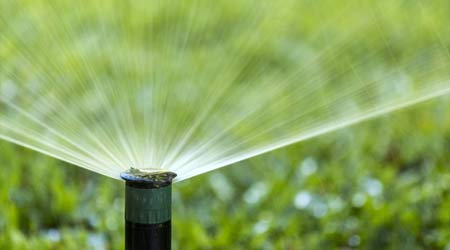Sustainable Practices Targeting Irrigation Systems
Part one of a three-part article on new-generation irrigation technology
As more organizations embrace sustainability, the practice of rainwater harvesting has become an attractive option for managers looking to supplement their facilities’ non-potable water needs. Rainwater harvesting has been around for centuries, but today, managers have access to more efficient practices for capturing rainwater, filtering it, and recycling it back into the landscape.
A rainwater harvesting system can either be simple or complex, depending on its use and objectives. For irrigating landscapes, managers should consider investing in an above-ground storage tank attached to a downspout. If they want to implement a system to supply multiple applications — toilets, irrigation, cooling, etc. — a more complex and expensive below-ground system probably is the most appropriate option.
For facilities with large landscapes and those located in regions that do not receive a sustainable amount of annual rainfall, rainwater harvesting for irrigation might not be reliable. If the area experiences frequent droughts, not enough water will be available to keep the landscape healthy and attractive. Beyond that, using rainwater collected from parking lots, sidewalks, and other service areas can increase the risk of infecting the landscape with oil run-off, which can kill vegetation.
Rainwater can be an appropriate option for other projects, but it is not the most suitable irrigation method for many facilities. On the other hand, graywater is an irrigation option that has helped tremendously with water conservation. Graywater is not safe to drink because it comes from sinks, showers, tubs, and washing machines, and it has not gone through water processing.
But it has many positive uses for the landscape. For example, while graywater might look dirty, it contains valuable nutrients that are beneficial to grass, plants, and flowers. From an economic and environmental standpoint, reusing graywater accomplishes many goals, including reducing a facility’s water bill and conserving the drinkable water supply.
Given the options, there is no reason managers cannot install a graywater line for a facility. Most municipalities actually offer facilities the opportunity to take advantage of a line. There is a small fee, but the amount a facility can save in water costs is significant, and the facility will not have to pay a sewage fee for the collected water. Managers should have a separate water meter installed to accurately read their property’s water use.
Managers need to keep several safety guidelines in mind if they are looking to use graywater to supplement fresh water for irrigation. Graywater should never be stored for more than 24 hours because it starts to smell, and managers should avoid pumps and filters, since they need routine upkeep and will add to energy costs. Managers also should have a three-way valve installed to switch between the graywater system and the sewer and septic system.
If managers can take advantage of these advances in irrigation technology and water-conservation initiatives, they can greatly decrease their organizations’ irrigation costs while also improving a facility’s environmental friendliness.
Mike Fitzpatrick is vice president of U.S. Lawns — www.uslawns.com — which has about 260 franchise locations nationwide. Fitzpatrick has more than 30 years of experience in the green industry.
Related Topics:















